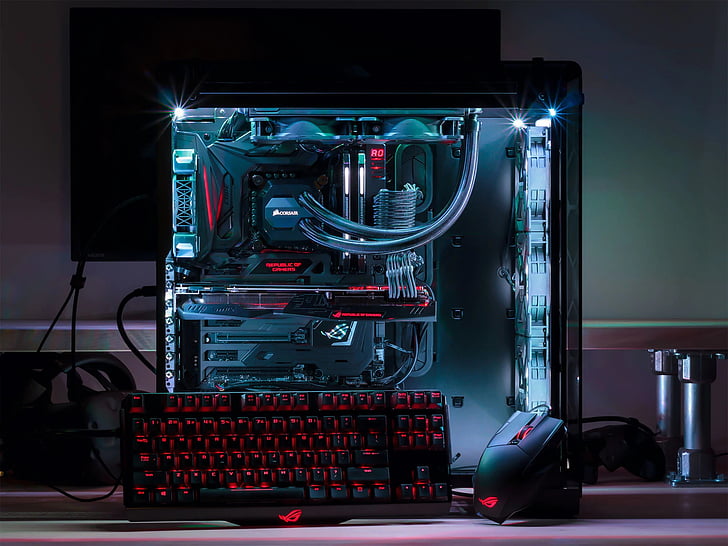Gaming websites represent a vibrant digital frontier where enthusiasts converge to explore a multitude of gaming experiences. From immersive MMORPGs that transport players to fantastical realms to casual gaming platforms that provide quick entertainment, these websites cater to diverse tastes and preferences. Understanding the various types of gaming websites allows players to find their niche, while also revealing the nuances in user engagement and community interaction that define each category.
Delving deeper into popular gaming website types, we discover an intricate landscape populated by esports platforms, casual games, and role-playing experiences. Each category boasts unique features, catering to distinct user demographics and engagement levels. By examining these elements, we can appreciate how different gaming websites meet the evolving demands of their audiences.
Popular Types of Gaming Websites
Gaming has evolved into a multifaceted industry with a plethora of websites catering to various tastes and preferences. From immersive MMORPGs to quick casual games and competitive esports platforms, these websites serve an ever-expanding audience. Each category offers distinctive experiences, community engagement opportunities, and features tailored to different types of players.
The landscape of gaming websites can be broadly categorized into three types: MMORPGs, casual gaming sites, and esports platforms. Each type not only differs in gameplay and audience but also in its core functionalities and user engagement metrics. Understanding these distinctions is crucial for players and developers alike, as they allow for tailored experiences that resonate with specific demographics.
MMORPGs
Massively Multiplayer Online Role-Playing Games (MMORPGs) are characterized by expansive worlds that host thousands of players simultaneously. Titles like “World of Warcraft” and “Final Fantasy XIV” exemplify this genre, where players can engage in quests, combat, and social interactions.
- Features: MMORPGs typically offer character customization, quest systems, guilds, PVP (Player versus Player) arenas, and a rich storytelling environment. They also provide routine updates and expansions to keep the content fresh.
- User Demographics: The audience for MMORPGs tends to be diverse, ranging from teenagers to adults in their 30s and 40s, often involving players who enjoy long-term engagement and complex narratives.
- Engagement Levels: Players often spend hundreds of hours in these games, thanks to the rich content and community-driven events.
Casual Gaming
Casual gaming websites focus on quick, easily accessible games that can be played in short bursts. Titles like “Candy Crush Saga” and “Among Us” have gained immense popularity due to their simplicity and social interaction features.
- Features: These sites offer a variety of games including puzzles, card games, and arcade-style games. They are usually free to play with optional in-game purchases.
- User Demographics: Casual gaming attracts a wider demographic, including younger audiences and older adults, with many players engaging in gaming as a leisure activity.
- Engagement Levels: Players often engage for shorter sessions, making these games popular for mobile play during commutes or breaks.
Esports Platforms
Esports platforms are dedicated to competitive gaming, hosting tournaments and leagues for professional players. Games like “League of Legends” and “Dota 2” showcase intense competition, attracting millions of viewers and participants.
- Features: These platforms provide live streaming, statistics tracking, ranked matchmaking, and community forums. They also feature a range of tournaments and events, often with substantial prize pools.
- User Demographics: Esports primarily attracts a younger audience, typically ages 18-34, who are interested in both playing and watching competitive games.
- Engagement Levels: Players and viewers often spend significant amounts of time engaging with content, including live streams, highlights, and commentary.
“The gaming industry has transformed into a global phenomenon, with various platforms catering to every kind of player.”
Understanding these gaming website types helps players choose the right platforms that fit their gaming style and community preferences, ultimately enhancing their overall experience in the gaming world.
Key Features of Successful Gaming Websites

Gaming websites thrive on a combination of engaging content, community interaction, and seamless user experience. The success of these platforms hinges on several critical features that cater to both casual gamers and dedicated enthusiasts. A well-designed gaming website creates an immersive environment where users can connect, explore, and enhance their gaming skills.
A successful gaming website incorporates essential features that not only attract users but also keep them engaged. The elements of user interface design, community forums, and monetization options, such as in-game purchases, greatly impact user retention and satisfaction. Below are some pivotal features that define the effectiveness of gaming websites.
User Interface Design
A user-friendly interface is vital for ensuring that visitors can navigate the website effortlessly. This includes intuitive layouts, appealing graphics, and easy-to-find information. The interface should cater to both novice and experienced gamers.
- Navigation: Clear menus and categorized sections make it easy for users to find games, reviews, and community features.
- Responsive Design: A layout that adapts to different devices enhances user experience across smartphones, tablets, and desktops.
- Visual Appeal: High-quality images and engaging graphics draw users in and create an immersive experience.
Community Forums
Community forums are essential for fostering user interaction and engagement. They provide a platform for gamers to share experiences, tips, and opinions.
- User Interaction: Forums facilitate discussions, allowing users to connect over shared interests and experiences.
- Support and Feedback: Gamers can seek help and provide feedback on games, enhancing the overall quality of the gaming environment.
- Event Announcements: Forums serve as a space to announce game updates, tournaments, and community events.
In-Game Purchases, Gaming websites
In-game purchases are a crucial revenue model for many gaming websites. They allow users to enhance their gaming experience through virtual goods.
- Monetization: Offering in-game items, skins, and upgrades can significantly boost revenue while providing value to players.
- Player Engagement: Well-implemented purchases can encourage players to spend more time in-game, enhancing overall satisfaction.
- Balance and Fairness: It’s important to ensure that in-game purchases do not create an unfair advantage, promoting a balanced gaming environment.
Comparison of Essential Features
The following table highlights the essential features of top gaming websites and their impact on user experience.
| Feature | Website A | Website B | Impact on User Experience |
|---|---|---|---|
| User Interface Design | Responsive, modern | Basic, outdated | High satisfaction, easy navigation |
| Community Forums | Active, moderated | Inactive, few posts | Strong community engagement |
| In-Game Purchases | Diverse options | Limited choices | Higher revenue, increased time spent |
Importance of Mobile Optimization
With the increasing use of mobile devices for gaming, optimizing websites for mobile is crucial. A mobile-optimized site ensures seamless access and functionality for users on the go.
- Accessibility: Mobile optimization allows users to access games anytime, enhancing engagement and convenience.
- Performance: Streamlined content and faster loading times improve user experience on mobile devices.
- Responsive Design Techniques: Utilizing flexible layouts, adaptive images, and CSS media queries can ensure a smooth mobile experience.
In conclusion, successful gaming websites depend on a blend of user interface design, community engagement, and monetization strategies that enhance user experience and satisfaction. The insights provided in this section serve as a foundation for understanding what makes these platforms thrive in a competitive landscape.
Trends in Gaming Website Development

As the gaming industry evolves, so too do the websites that cater to its diverse audience. Emerging technologies and innovative practices are reshaping the landscape of gaming websites, making them more interactive, user-friendly, and engaging. This section delves into the latest trends that are driving the development of gaming websites, examining the impact of technologies such as virtual reality and cloud gaming, the significance of user-generated content, and best practices tailored for the gaming industry.
Impact of Emerging Technologies
The advent of technologies like virtual reality (VR) and cloud gaming is revolutionizing the gaming experience offered by websites. VR delivers immersive environments that engage players in ways traditional media cannot. For example, platforms such as Oculus Quest have shown how VR can transform gaming into a fully interactive experience, where users feel as if they are part of the game world. Meanwhile, cloud gaming services, such as Google Stadia and NVIDIA GeForce Now, eliminate the need for high-end hardware, allowing players to stream games directly from the web. This trend enables gaming websites to provide access to an extensive library of games without the constraints of physical downloads or high-spec devices, making gaming more accessible.
User-Generated Content in Gaming Websites
The role of user-generated content (UGC) in gaming websites has become increasingly prominent, driving engagement and community building. Websites that allow users to create, share, and modify content foster a sense of ownership and involvement among players. Notable examples include platforms like Roblox and Fortnite, which empower users to design their own games and experiences. This model not only enhances user interaction but also contributes to a continuous influx of fresh content, keeping the gaming community vibrant and engaged. Incorporating UGC on gaming websites encourages players to participate actively, share their creativity, and enhance the overall gaming experience.
Best Practices for Gaming Website Development
To create a successful gaming website, developers should adhere to specific best practices that cater to the unique needs of gamers. These strategies ensure that the site is engaging, functional, and user-friendly. The following list Artikels essential practices in gaming website development:
- Responsive Design: Ensure the website is fully functional across different devices, including desktops, tablets, and smartphones, to accommodate a wide range of players.
- Fast Load Times: Optimize website speed, as delays can frustrate users and drive them away, particularly in gaming where quick access is crucial.
- Intuitive Navigation: Design an easy-to-use interface that allows users to find games, forums, and features quickly, enhancing the overall user experience.
- Community Features: Incorporate forums, chatrooms, and social sharing options to strengthen the community aspect and encourage player interaction.
- Security Measures: Implement robust security protocols to protect user data and transactions, fostering trust and encouraging active participation.
Last Recap

In summary, gaming websites are not just platforms; they are dynamic ecosystems that foster community, innovation, and engagement. With the continuous evolution of technology and user preferences, the future of gaming websites looks promising, filled with opportunities for interactive experiences and community contributions. As players navigate this thrilling landscape, understanding the key features and trends will empower them to make informed choices and enhance their gaming adventures.

